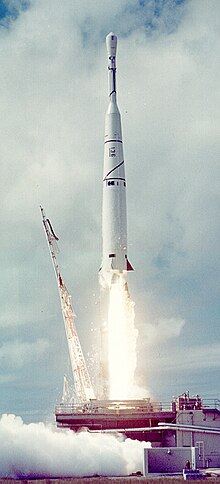
The PGM-17A Thor was the first operational ballistic missile of the United States Air Force (USAF). Named after the Norse god of thunder, it was deployed in the United Kingdom between 1959 and September 1963 as an intermediate-range ballistic missile (IRBM) with thermonuclear warheads. Thor was 65 feet (20 m) in height and 8 feet (2.4 m) in diameter. It was later augmented in the U.S. IRBM arsenal by the Jupiter.

The Thor-Able was an American expendable launch system and sounding rocket used for a series of re-entry vehicle tests and satellite launches between 1958 and 1960. It was a two-stage rocket, consisting of a Thor IRBM as a first stage and a Vanguard-derived Able second stage. On some flights, an Altair solid rocket motor was added as a third stage. It was a member of the Thor family and an early predecessor of the Delta.

Thor was a US space launch vehicle derived from the PGM-17 Thor intermediate-range ballistic missile. The Thor rocket was the first member of the Delta rocket family of space launch vehicles. The last launch of a direct derivative of the Thor missile occurred in 2018 as the first stage of the final Delta II.

This comparison of orbital launch systems lists the attributes of all individual rocket configurations designed to reach orbit. A first list contains rockets that are currently operational or in development; a second list includes all retired rockets. For the simple list of all conventional launcher families, see: Comparison of orbital launchers families. For the list of predominantly solid-fueled orbital launch systems, see: Comparison of solid-fueled orbital launch systems.

The AJ10 is a hypergolic rocket engine manufactured by Aerojet Rocketdyne. It has been used to propel the upper stages of several launch vehicles, including the Delta II and Titan III. Variants were and are used as the service propulsion engine for the Apollo command and service module, in the Space Shuttle Orbital Maneuvering System, and on NASA's Orion spacecraft.

The Thor-Ablestar, or Thor-Able-Star, also known as Thor-Epsilon was an early American expendable launch system consisting of a PGM-17 Thor missile, with an Ablestar upper stage. It was a member of the Thor family of rockets, and was derived from the Thor-Able.
The N-II or N-2 was a derivative of the American Delta rocket, produced under licence in Japan. It replaced the N-I-rocket in Japanese use. It used a Thor-ELT first stage, a Delta-F second stage, nine Castor SRMs, and on most flights either a Star-37E or Burner-2 upper stage, identical to the US Delta 0100 series configurations. Eight were launched between 1981 and 1987, before it was replaced by the H-I, which featured Japanese-produced upper stages. All eight launches were successful.
The Thor DSV-2 was a series of sounding rockets, test vehicles, and anti-satellite weapons derived from the Thor Intermediate-range ballistic missile. It was also used as the first stage of several Thor-derived expendable launch systems

The Thor-Delta, also known as Delta DM-19 or just Delta was an early American expendable launch system used for 12 orbital launches in the early 1960s. A derivative of the Thor-Able, it was a member of the Thor family of rockets, and the first member of the Delta family.
The Delta A, or Thor-Delta A was an American expendable launch system used to launch two Explorer spacecraft in October 1962. A derivative of the Thor-Delta, it was a member of the Delta family of launch vehicles. The Thor-Delta itself was a Thor booster with an Able second stage and Altair third stage.
The Delta J, or Thor-Delta J was an American expendable launch system of the late 1960s. Only one was launched, with the Explorer 38 spacecraft. It was a member of the Delta family of rockets.

The Delta L, Thor-Delta L, or Thrust-Augmented Long Tank Thor-Delta was a US expendable launch system used to launch the Pioneer E and TETR satellites in 1969 (failed) and HEOS satellite in 1972. It was a member of the Delta family of rockets.

The Able rocket stage was a rocket stage manufactured in the United States by Aerojet as the second of three stages of the Vanguard rocket used in the Vanguard project from 1957 to 1959. The rocket engine used nitric acid and UDMH as rocket propellants. The Able rocket stage was discontinued in 1960. The improved Ablestar version was used as the upper stage of the Thor-Ablestar two stage launcher. The Ablestar second stage was an enlarged version of the Able rocket stage, which gave the Thor-Ablestar a greater payload capacity compared to the earlier Thor-Able. It also incorporated restart capabilities, allowing a multiple-burn trajectory to be flown, further increasing payload, or allowing the rocket to reach different orbits. It was the first rocket to be developed with such a capability and development of the stage took a mere eight months.









